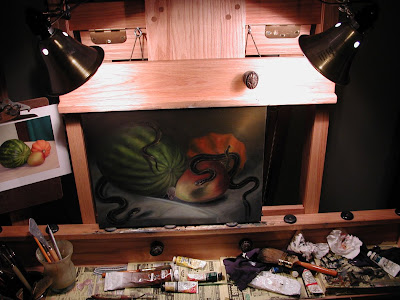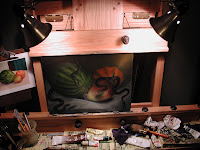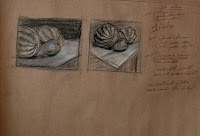 So with a few instructions from my art teacher on bringing the painting to a finish. I felt like I needed to take this painting somewhere else, somewhere personal. So after an in depth discussion on composition with my niece and nephew ages ten and twelve, we decided that this still life would benefit from a little creative licensing. I made the suggestion of adding the snakes looking for a mouse and they told me where they would look best in the painting. Rocco suggested hanging the snakes tail off the table on the right side and having the snake on the left wrap around the watermelon. Megan agreed and said the mouse should be hiding in the center. I’m still working on this one guys, I just wanted to post it to see if I’m on the right track?
So with a few instructions from my art teacher on bringing the painting to a finish. I felt like I needed to take this painting somewhere else, somewhere personal. So after an in depth discussion on composition with my niece and nephew ages ten and twelve, we decided that this still life would benefit from a little creative licensing. I made the suggestion of adding the snakes looking for a mouse and they told me where they would look best in the painting. Rocco suggested hanging the snakes tail off the table on the right side and having the snake on the left wrap around the watermelon. Megan agreed and said the mouse should be hiding in the center. I’m still working on this one guys, I just wanted to post it to see if I’m on the right track? Sunday, October 26, 2008
Snake oil painting
 So with a few instructions from my art teacher on bringing the painting to a finish. I felt like I needed to take this painting somewhere else, somewhere personal. So after an in depth discussion on composition with my niece and nephew ages ten and twelve, we decided that this still life would benefit from a little creative licensing. I made the suggestion of adding the snakes looking for a mouse and they told me where they would look best in the painting. Rocco suggested hanging the snakes tail off the table on the right side and having the snake on the left wrap around the watermelon. Megan agreed and said the mouse should be hiding in the center. I’m still working on this one guys, I just wanted to post it to see if I’m on the right track?
So with a few instructions from my art teacher on bringing the painting to a finish. I felt like I needed to take this painting somewhere else, somewhere personal. So after an in depth discussion on composition with my niece and nephew ages ten and twelve, we decided that this still life would benefit from a little creative licensing. I made the suggestion of adding the snakes looking for a mouse and they told me where they would look best in the painting. Rocco suggested hanging the snakes tail off the table on the right side and having the snake on the left wrap around the watermelon. Megan agreed and said the mouse should be hiding in the center. I’m still working on this one guys, I just wanted to post it to see if I’m on the right track? Tuesday, October 14, 2008
oil painting values, tempature and edges
Learning Techniques for Oil Painters

There are many ways to learn the tricks of the trade when it comes to oil painting.
For now I'd like to take a moment to talk about a system I use for gather information from today’s top artists from around the world, and I can do it all without leaving my house
Art magazines and art forums supply an endless amount of information on technique, composition, color mixing, mediums, palette, paint properties, proportion, value and much more.
The information is all right there at your fingertips. The problem is that its scattered all over the place from, article to magazine article and forum to forum post. Sure I can read an artists clever oil painting technique one day and in a month or two I'm still staring at the canvas trying to remember what the heck he was talking about.
So to conquer this problem I have been taking notes from all of them as if they were my teacher. I have note books and binders filled with very useful information on there methods and techniques.
For instance when ever I come across a useful idea in an artist magazine I immediately highlight it and then copy it to one of my note books. My note books are categorized for easy retrieval of this information when needed.
I have a note book for technique, color properties, color mixing, flesh palette, portrait painting, linear prospective, composition, value and so on. When I come across a new useful category I simply start a new note book and title it for that subject.
While on line I simply highlight the information that I want to retain then copy and past it to a word file labeled for that topic. It's amazing how generous accomplished artists are with this information and their words have been a great inspiration and help to me on my journey to learning how to oil paint.
Saturday, October 4, 2008
Oil Painting Glazing Technique Using Liquin
 Here I am a couple of days into the project. I started out by applying a dark wash mix of burnt umber , alizarin crimson, french ultramarine blue and indigo over the whole canvas, then I used a rag to draw the painting by removing the wash.
Here I am a couple of days into the project. I started out by applying a dark wash mix of burnt umber , alizarin crimson, french ultramarine blue and indigo over the whole canvas, then I used a rag to draw the painting by removing the wash.Then using the liquin I started with cadmium yellow light. Gradually layered the colors to bring the painting together. Our instructor was kind enough to take digital pictures for all of us, which allowed us to continue work at home.
I still have a few more sessions to go before I complete this painting , but I thought it would be interesting to post my progress.
Some notes on the different types of liquin:
Liquin is a durable, non-yellowing medium for thinning oil and alkyd colors, and speeding drying time. Winsor & Newton has extended their popular line of Liquin with three superb, new products.
Original Liquin — Excellent for glazing and producing fine detail, as well as speeding drying time.
Liquin Fine Detail — Reproduces traditional Copal medium for detail work, glazing, and smooth blending without brush marks. Dries to a gloss finish.
Liquin Impasto — Retains crisp textures and brush strokes. Extends tube color and dries to a semi-gloss finish.
Liquin Light Gel — Breaks down immediately when brushed, and creates a non-drip, smooth effect,
Oil Painting Glazing Technique Using Liquin
.jpg) Art classes started up a few weeks ago at the Arts Guild of Rahway, Our first assignment is a still life using a glazing technique.
Art classes started up a few weeks ago at the Arts Guild of Rahway, Our first assignment is a still life using a glazing technique.I’m using oil paints with liquin as my medium on a toned canvas.
After close observation of the still life arrangement ( watermelon, mango and pumpkin).
We started out with a few quick thumb nail sketches to develop composition.
Subscribe to:
Comments (Atom)
